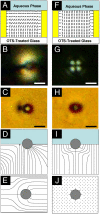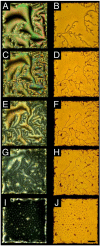Chemoresponsive assemblies of microparticles at liquid crystalline interfaces
- PMID: 20133750
- PMCID: PMC2840171
- DOI: 10.1073/pnas.0910931107
Chemoresponsive assemblies of microparticles at liquid crystalline interfaces
Abstract
Assemblies formed by solid particles at interfaces have been widely studied because they serve as models of molecular phenomena, including molecular self-assembly. Solid particles adsorbed at interfaces also provide a means of stabilizing liquid-liquid emulsions and synthesizing materials with tunable mechanical, optical, or electronic properties. Whereas many past studies have investigated colloids at interfaces of isotropic liquids, recently, new types of intercolloidal interactions have been unmasked at interfaces of liquid crystals (LCs): The long-range ordering of the LCs, as well as defects within the LCs, mediates intercolloidal interactions with symmetries that differ from those observed with isotropic liquids. Herein, we report the decoration of interfaces formed between aqueous phases and nematic LCs with prescribed densities of solid, micrometer-sized particles. The microparticles assemble into chains with controlled interparticle spacing, consistent with the dipolar symmetry of the defects observed to form about each microparticle. Addition of a molecular surfactant to the aqueous phase results in a continuous ordering transition in the LC, which triggers reorganization of the microparticles, first by increasing the spacing between microparticles within chains and ultimately by forming two-dimensional arrays with local hexagonal symmetry. The ordering transition of the microparticles is reversible and is driven by surfactant-induced changes in the symmetry of the topological defects induced by the microparticles. These results demonstrate that the orderings of solid microparticles and molecular adsorbates are strongly coupled at the interfaces of LCs and that LCs offer the basis of methods for reversible, chemosensitive control of the interfacial organization of solid microparticles.
Conflict of interest statement
The authors declare no conflict of interest.
Figures






Comment in
-
Liquid crystals enable chemoresponsive reconfigurable colloidal self-assembly.Proc Natl Acad Sci U S A. 2010 Mar 2;107(9):3945-6. doi: 10.1073/pnas.1000312107. Epub 2010 Feb 26. Proc Natl Acad Sci U S A. 2010. PMID: 20190182 Free PMC article. No abstract available.
Similar articles
-
Recent advances in colloidal and interfacial phenomena involving liquid crystals.Langmuir. 2011 May 17;27(10):5719-38. doi: 10.1021/la103301d. Epub 2010 Nov 19. Langmuir. 2011. PMID: 21090596 Free PMC article. Review.
-
Ordering of solid microparticles at liquid crystal-water interfaces.J Phys Chem B. 2008 Dec 25;112(51):16552-8. doi: 10.1021/jp807286s. J Phys Chem B. 2008. PMID: 19049270
-
Soft matter from liquid crystals.Soft Matter. 2019 Sep 21;15(35):6913-6929. doi: 10.1039/c9sm01424a. Epub 2019 Aug 23. Soft Matter. 2019. PMID: 31441481
-
Design of Functional Materials based on Liquid Crystalline Droplets.Chem Mater. 2014 Jan 14;26(1):496-506. doi: 10.1021/cm4025028. Chem Mater. 2014. PMID: 24882944 Free PMC article.
-
Design of Responsive and Active (Soft) Materials Using Liquid Crystals.Annu Rev Chem Biomol Eng. 2016 Jun 7;7:163-96. doi: 10.1146/annurev-chembioeng-061114-123323. Epub 2016 Mar 10. Annu Rev Chem Biomol Eng. 2016. PMID: 26979412 Free PMC article. Review.
Cited by
-
Using liquid crystals to reveal how mechanical anisotropy changes interfacial behaviors of motile bacteria.Biophys J. 2014 Jul 1;107(1):255-65. doi: 10.1016/j.bpj.2014.04.047. Biophys J. 2014. PMID: 24988359 Free PMC article.
-
Recent advances in colloidal and interfacial phenomena involving liquid crystals.Langmuir. 2011 May 17;27(10):5719-38. doi: 10.1021/la103301d. Epub 2010 Nov 19. Langmuir. 2011. PMID: 21090596 Free PMC article. Review.
-
Large-area optoelastic manipulation of colloidal particles in liquid crystals using photoresponsive molecular surface monolayers.Proc Natl Acad Sci U S A. 2011 Dec 27;108(52):20891-6. doi: 10.1073/pnas.1112849108. Epub 2011 Dec 12. Proc Natl Acad Sci U S A. 2011. PMID: 22160673 Free PMC article.
-
Elastocapillary interactions on nematic films.Proc Natl Acad Sci U S A. 2015 May 19;112(20):6336-40. doi: 10.1073/pnas.1504817112. Epub 2015 May 4. Proc Natl Acad Sci U S A. 2015. PMID: 25941380 Free PMC article.
-
Defect-mediated colloidal interactions in a nematic-phase discotic solvent.RSC Adv. 2019 Oct 17;9(57):33413-33427. doi: 10.1039/c9ra05377h. eCollection 2019 Oct 15. RSC Adv. 2019. PMID: 35529161 Free PMC article.
References
-
- Collings PJ. Liquid Crystals: Nature’s Delicate Phase of Matter. Princeton, NJ: Princeton Univ Press; 1990.
-
- Musevic I, Skarabot M, Tkalec U, Ravnik M, Zumer S. Two-dimensional nematic colloidal crystals self-assembled by topological defects. Science. 2006;313:954–958. - PubMed
-
- Poulin P, Stark H, Lubensky TC, Weitz DA. Novel colloidal interactions in anisotropic fluids. Science. 1997;275:1770–1773. - PubMed
-
- Oettel M, Dietrich S. Colloidal interactions at fluid interfaces. Langmuir. 2008;24:1425–1441. - PubMed
-
- Nych AB, et al. Coexistence of two colloidal crystals at the nematic-liquid-crystal-air interface. Phys Rev Lett. 2007;98:057801. - PubMed
Publication types
MeSH terms
Substances
LinkOut - more resources
Full Text Sources
Miscellaneous

